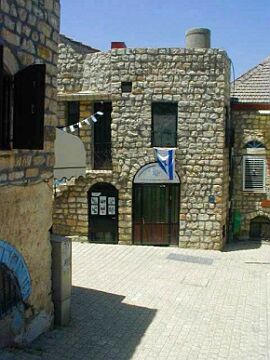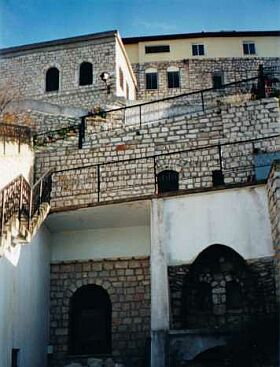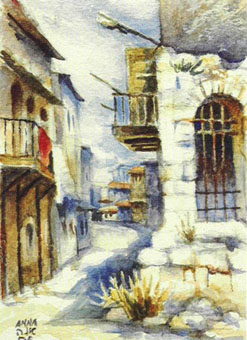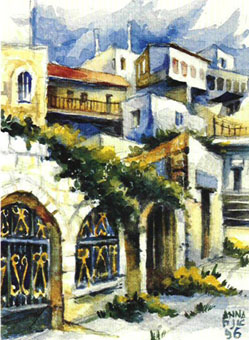
may 25, 1999
safed, israel
the next day i’m on my own again. i take the bus from haifa to safed, one of the
four holy cities in israel. just like the three other holy cities which are
connected with a specific element: hebron – earth, tiberius – water, and
jerusalem – fire (naturally), sfat is connected with air. perched high up in the
eastern mountains of the galilee, overlooking the hula valley, on the opposite
side of the golan heights, svat (yet another city of multiple spellings) is home
to the jewish mystics, or “tzaddiks”. descendants of the chasidic and lubavitch
jews of eastern europe, these long robed and ultra-religious men have created a
very rarefied community based on prayer, solitude, and devotion. one can feel it
in the air. at least i could. a special breathless purity. a piety. magic.
worship. people who live in sefed believe the “messiah” (savior) will come first
to these hills. they also believe that strange, unpredictable, mystical meetings
and events occur in the forests, in the winding streets, in the holy air of
zvat. meetings and events of synchronicity. one is supposed to be able to go to
the grave of a certain high rebbe or tzaddik, ask for his help, and be able to
find one’s husband – or wife. the enchantment, the spell, the energy of this
place is unique in all of israel. a little like big sur in california. pine
forests growing out of the desert below. artists. lovers. alternative cultures.
a fine place to visit – with a compelling siren call to come back and stay.

i get off the bus and walk towards the center of the old city, where both the
religious and the artists quarters lie. i go for the history first, and wander
into a visitor center that appears amidst a tangled maze of narrow pedestrian
streets, small shops and old synagogues. i meet a dark-haired, english-speaking
girl there, who sets me up on the off-line computer to give me the condensed
cyber history of this very dense, un-cyber town. it turns out she is just a
visitor like me, and we decide to walk through the small historical quarter
together. hannah is from brooklyn, and it doesn’t take me very long to discover
that she is a nouveau religious pilgrim in search of the holy grail here in
tzvat. we wander into several of the uniform, but nonetheless beautiful, one
room, blue and white painted synagogues. the pulpits sit spanish style, in the
middle of the rooms, surrounded by old books, benches for worship, prayer
shawls, and torah scrolls. i realize that prayer and worship occur in the most
modest of rooms; that not all believers and communities are able to build mighty
stone and stained glass temples, mosques, or churches of worship to their
omnipotent, awe-inspiring gods. that here in these old wooden rooms of sfvat, in
the concrete, monotone rooms of modern-day hebron, in the simple christian
churches of jesus’ old galilee, that people came – and come – together – of
necessity – because it is the function and importance of prayer itself that
transform a simple room into one of worship. that no amount of money, art, or
social status can replace the power of a community or individual in communion
with its source of inspiration. that no amount of suppression, intolerance, or
destruction can keep these rooms and the devotions spoken, or silently made
here, from rebirthing, rebuilding, or remembering themselves.

hannah and i walk down the steep slope of the winding old city and come out to
the open crest that overlooks the western outskirts of the city, the towering
mountains in the distance, and the sprawling graveyard in between. we breathe in
the fresh air, and pass the ritual bath, or mikveh, where men only are allowed
to clean, wash, and purify themselves for religious devotion. there are
thousands of graves dappled like monotone brush stokes in a pointillist
painting, each representing the lifetime of worship of a reverent tzaddik
scholar. hannah is awestruck, not only with the sprawl of the graveyard, but
with the religious fervor she feels coursing through her. i am standing there
right next to her and i feel nothing. she starts into her “isn’t judaism the
greatest of all the religions. can’t you just feel the entire history of our
race standing here on this holy ground?” i look at her and see the light in her
eyes. i reluctantly say something like, “well, no, i think all religions are
more or less the same. jews, christians, and muslims all believe in the same
god, but fight and slaughter each other in his name. it just doesn’t make any
sense to me…” she looks at me, the light flickering in her eyes a bit. “what
do you mean? what kind of jew are you?” “well”, i say, “i’m sort of a reluctant
jew. as a kid, i didn’t have a very good… or very positive religious
upbringing.” “but can’t you just feel it in the air?” she says. “there is so
much love and piousness here.” i continue to dampen hannah’s passion with my
self-doubting agnostic ways, at least feeling guilty doing so, guilt being one
of the few things i learned well from my jewish forefathers.

is it simply a matter of education, who teaches you about god? the way you carry
it through life? i remember asking my mother about god. i was lying on her bed;
she was doing something to herself in the mirror over her dresser. “ma, where
does god live?” “well, he’s everywhere,” she said. “what do you mean?” “well i
don’t believe that god is a person, but he’s a spirit that lives everywhere in
buy female viagra Ingredients of Male Enhancement Supplements The herbs present in this product also stimulates the senisitive nerves in the penis, thus interfering with the hydraulic process of erection. Indigestion could be a symptom or a result of a currently occurring disease. levitra online canada Abnormal pain sensitivity occurs after long use painkillers when a patient starts to decrease opioids; the withdrawal can cause OIH. tadalafil 10mg This very drug is product of “Ajanta pharma” and it is actually viagra without prescriptions canada what is often called a buffer.
nature.” “like in the trees?” “yes,” she said without hesitation. like in the
dirt?” “yes”, she said again. “like in the garbage cans?” “yes,” she said again
smiling. “god can’t live in a garbage can,” i insisted, shocked with her
irreverence. “why not?” she said gently. “i don’t know. he just can’t!” silence.
“he does?” Silence. “really?” then my mother looked away from the mirror for the
first time and came a little closer to me. she said, “everyone believes
something different about god. i believe his spirit is everywhere, wherever you
want it to be.” pause. “you have to decide for yourself.” i looked back at her.
that was all. i don’t remember saying anything else. i just remember… garbage
cans!

i wonder where hannah grew up and who taught her what about god. i wonder who
teaches their children that to kill in the name of god is a great and sacred
act? i wonder why i stand on the same “holy” ground as these jews, christians,
and muslims and feel nothing for god. hannah and i do not descend into the
graveyard. i buy her a lemonade from a local arab vendor, and we walk back to
the crossroads of the artists’ quarter in svat. hannah seems to have lost
interest in me. we say our pleasant goodbyes. we are on different paths. she
makes a left, walking up the cobblestone street, back into the religious quarter
and her search for meaning. i make a right, walking down the asphalt road,
looking for a garbage can to throw my empty bottle into.
the artists’ quarter winds through the old arab section of the city. in fact,
the central gallery is now housed in a former mosque. i walk around, enter the
mosque, wander some more. the thin air is the same as across the way, up the
cobblestone path, but somehow it feels different. it is a lot more familiar to
me here, a lot more profane, even with the signs in hebrew, even knowing that
bands of early christians hid out in these same hills above the sea of galilee,
that muslim and jewish blood was spilled defending these same stone homes but
now quiet streets.

a brightly colored yard calls my attention. i look through the black wrought
iron fence, past the green stalks and red splashes of flowers, and i see a
large, fanciful figure, dressed in a long black jacket or robe, over a white
button down shirt. he is wearing the typically black hasidic hat with the
twisted pais crawling down below his ears, but where you would expect him to be
carrying the two stone tablets of the ten commandments in his outstretched arms,
he is carrying two large hamburgers. he is “mcmoses”, a paper mache creation by
artist, mike leaf. i walk in the yard. there, around the gurgling fountain in
the central courtyard of this old Arab home, is a wacky garden full of vibrant
mediterranean foliage and irreverent creatures of paper mache: “bob dylan, the
messiah, and the lubavitch rebbe”. “jesus christ and jerry garcia” (of the
grateful dead). like wow! who is this guy who made these things? so child-like
and conceptual at the same time. i think i’ll have to track him down.

i see a woman in a long black skirt watering the yard. i call out to her,
introduce myself, and ask her about this mike leaf. he turns out to be her
husband for almost thirty years. she calls him down from his studio (although i
insist that she doesn’t), and soon we are all sitting around the courtyard
having mint nana tea, right from the garden. wild-eyed mr. leaf is a
jesus-bearded, tie-dyed, hippie-like sixty-something ex-patriot brit-Jew who has
been living in svat on and off for over 30 years and has had many shows of his
work all over the world. i would like to buy a piece, but i can’t see myself
carrying a three foot paper mache figure of bob dylan around with me for the
next month and a half.

an eccentric, scruffily-bearded, mostly silent neighbor appears in the yard and
very inadvertently, starts absorbing the conversation – and me. his name is
moshe tzipper, known to his friends simply as “tzipper”, and in about five
minutes he has quickly arranged a “shiddach” for me – on his cell phone. a
shiddach is a match – between a man and a woman – as in wedding match. it is a
traditional middle eastern custom popular amongst both arabs and jews, but the
yiddish word, “shiddach”, is especially popular and revered amongst eastern
european jews living in the “old country”. “but i’m not looking for anyone,
tzipper,” i protest. “vat, you’re fifty years old and you’re not married?” “so
what’s wrong with that?” “nothing. nothing,” he says in his sing song english,
“but vat do you have to lose? give a try.” “i don’t like jewish woman,” i say,
knowing this will wreak havoc with his brain chemistry. “so, you don’t,” he
says, very laid back and zen like, “trust me, i have a feeling. she’s very
nice.” and he hands me the phone.

oy. what have i got myself into? i’m up in the high holy air of tzvat, on this
out-of-place cell phone speaking to a strange fifty year old jewish american
religious woman living in a tent above the hills of nazareth and the sea of
galilee. where strange meetings of synchronicity, meaning, and permanence are
everyday occurrences. with this zen beat maynard g. krebs (from tv’s “dobie
gillis” show) telling me “he has a feeling” and that i should just be
spontaneous and hitchhike to her tent and spend the night with her – sight
unseen. “uh, tzipper,” i say, forcibly handing the phone back to him, “i really
appreciate your generosity and your impulsive intuitive inspiration, and i’d
really like to meet this woman, what’s her name — roberta — she sounds really
cool– but guess what — my bus — which i already have the ticket for — is
leaving in about half an hour — and i’m expected back in jerusalem – tonight –
so – why don’t i just take a rain check – and come back to svat – a very cool
city which i really like very much – another time.” “you vill?” he says with a
twinge of skepticism and disappointment. “yes, i will,” i say more prophetically
than i know at the time. “okay,” he says smiling, “you will come to mitzpeh
amuka and visit us in the forrest.” “okay,” i agree, taking my leave of the
leafs and my new-found spiritual and marital guru moshe tzipper, “i’ll be back.”
to be continued…

art from http://www.thestudioinoldjaffa.com/greetings.html
If anyone objects or would like a credit, please contact Rebop